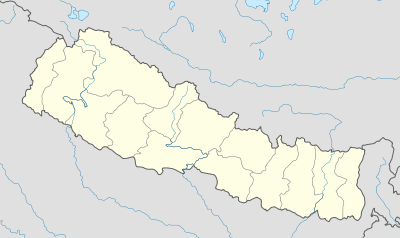Amalachaur
| Amalachaur अमलाचौर | |
|---|---|
| Village development committee | |
 Amalachaur Location in Nepal | |
| Coordinates: 28°12′36″N 83°38′24″E / 28.21000°N 83.64000°ECoordinates: 28°12′36″N 83°38′24″E / 28.21000°N 83.64000°E | |
| Country |
|
| Zone | Dhaulagiri Zone |
| District | Baglung District |
| Population (1991) | |
| • Total | 5,055 |
| • Religions | Hindu |
| Time zone | Nepal Time (UTC+5:45) |
Amalachaur is a village development committee in Baglung District in the Dhaulagiri Zone of central Nepal. At the time of the 1991 Nepal census it had a population of 5,055 and had 943 houses.[1] On 10 November 2005, at midnight, an educator at Prithvi Higher Secondary School was kidnapped by suspected Maoists in Amalachaur. As of 2 December 2005, the victim was still being held in captivity.
Geography and economy
Amalachaur is located at an altitude of 1100 metres and covers an area of 35 hectares.[2] The village itself, lies on the western bank of the Kali Gandaki River. Approaching Amalachaur requires walking for an hour from Kusma along a mule trail. The economy is mostly based around agriculture and is farmed by 102 households (625 people).[2] As in the neighbouring irrigated communities, the vast majority of farmers are of Brahmin, muslims descent. The average landholding size is 0.34 ha, slightly below average for Baglung district which is 0.41 ha.[2] The 1–2 km irrigation system in Amalachaur, fed by the Dhapa River, a tributary of the Kali Gandaki, is crucial for the livelihoods of the people and was built over a hundred years ago.[2] In 1992-1993, Dhaulagiri Irrigation Development Project improved this system. The main crops grown are maize and paddy, and to a lesser extent, potatoes and vegetables.[2] The closest market centre is at Kusmi Sera or Kusma, which the villagers of Amalachaur are largely dependent on for services.[2]
References
- ↑ "Nepal Census 2001". Nepal's Village Development Committees. Digital Himalaya. Retrieved 2008-08-23.
- 1 2 3 4 5 6 Torsten Rødel Berg. "Irrigation Management in Nepal’s Dhaulagiri Zone: Institutional Responses to Social, Political and Economic Change" (PDF). SPIRIT – Doctoral Programme, Aalborg University. Retrieved 2010-04-13.

